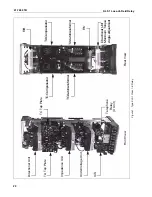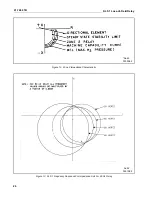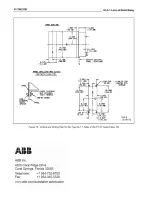
41-748.31B
18
KLF-1 Loss-of-Field Relay
the directional unit need not be cooled
during initial rough adjustment. But, the
directional unit should be cool when final
adjustment is made.
e.
When relay contact closes to the left,
screw out the right-hand plug until spuri-
ous torque is reversed.
f.
When plug adjustment is completed
check to see that there is no closing
torque when relay is energized with 40
amps and voltage terminals 4 and 6
short-circuited.
E. Undervoltage Unit (Lower Unit)
NOTE: The moving contact is in closed position
to the left when de-energized.
1) Contact Gap Adjustments
a.
L.H. (Normally Closed) Contact Adjustment
With the moving contact arm in the closed
position, against left-hand side of bridge,
screw the left-hand contact in to just touch
the moving contact (use neon light for indica-
tion) and then continue for one more com-
plete turn.
b.
R.H. (Normally Open) Contact Adjustment
With moving contact arm against the left-
hand stationary contact, screw the right-hand
stationary contact until it just touches the
moving contact. Then back the right-hand
contact out two-thirds of one turn to give
0.020 inch contact gap.
2)
Sensitivity Adjustment
a.
Apply voltage to terminals 4 & 7. Connect
the brush lead of the adjustable resistor,
R
V
, that is located in the rear (second from
the bottom) to maximum. Adjust the spring
so that contacts make (to the left) at 70
volts. The contact should open when unit
is energized with 71 or more volts.
b.
Relay is set for 90 volts. This is accom-
plished by lowering resistance value of R
V
until contacts make at 90 volts and open
when unit is energized with 91 or more
volts. The spring should not be used for
this setting.
F. Indicating Contactor Switch (ICS)
Initially adjust unit on the pedestal so that arma-
ture fingers do not touch the yoke in the reset
position. (Viewed from top of switch between
cover and frame.) This can be done by loosening
the mounting screw in the molded pedestal and
moving the ICS in the downward position.
1. Contact Wipe – Adjust the stationary contact
so that both stationary contacts make with
the moving contacts simultaneously and
wipe 1/64” to 3/64” when the armature is
against the core.
2.
Target – Manually raise the moving contacts
and check to see that the target drops at the
same time as the contacts make or up to
1/16” ahead. The cover may be removed and
the tab holding the target reformed slightly if
necessary. However, care should be exer-
cised so that the target will not drop with a
slight jar.
3.
Pickup – The unit should pickup at 98% rat-
ing and not pickup at 85% of rating. If neces-
sary, the cover leaf springs may be adjusted.
To lower the pickup current use a tweezer or
similar tool and squeeze each leaf spring
approximately equal by applying the tweezer
between the leaf spring and the front surface
of the cover at the bottom of the lower win-
dow.
4. If the pickup is low, the front cover must be
removed and the leaf spring bent outward
equally.
G. Solid State Time Delay Circuit
Refer to Figure 14 (page 27) for the following
test:
a.
Connect a jumper between the “D” contacts
(top unit) and connect a switch between the
D-contact and relay terminal 10.
b.
Connect a scope probe, common and exter-
nal trigger to relay terminals 1, 3 and contact
“D” respectively.
c.
Connect a rated dc power supply between
relay terminals 10 (+) and 3 (-).
d.
Turn on the dc power supply and then turn
on the switch. The voltage at terminal 1











































